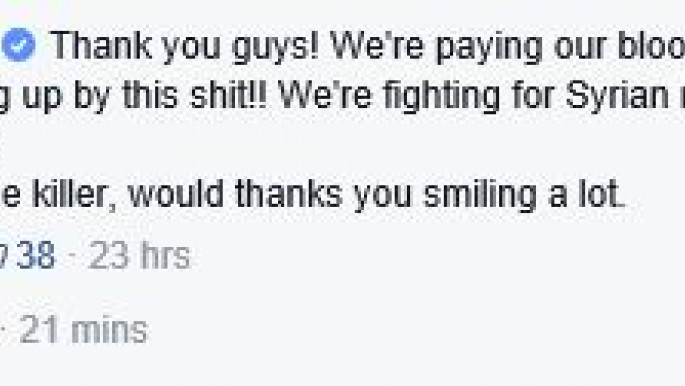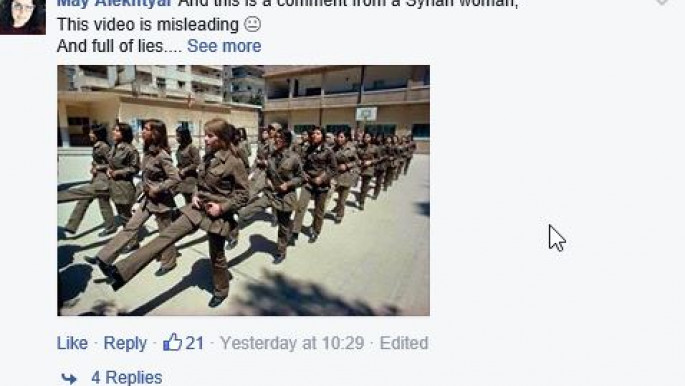
Syrians angered by '100 years of beauty' video
A video showing a century of fashion in Syria, has angered Syrians, and an effort they say would make Assad's own propagandists proud.
3 min read
Cut.com's Syria video has come under fire from Syrians for alleged inaccuracies [Youtube screenshot]
A series of time lapse videos by Cut.com showing fashion trends of the past century has been a huge hit with stylists.
However, 100 years of beauty's latest attempt to meld fashion with politics has ended on a sour note.
Cut.com's video showing fashion trends in Syria from 1910 to the present day have slammed as crude, insensitive, and unhistorical by style lovers from the region.
The video begins with with model Jessica Damouni wearing a simple, loosely-worn headscarf to depict Syrian fashion in 1910.
Cut's makeover team then went to great lengths to take viewers through a colourful spectrum of looks.
It includes a red-lipsticked model in a Marilyn Monroe-esqe style representing trends in the 1940s, through to the flowery-haired Ghada al-Samman-inspired chic of the 1960s.
Then, as the video approaches 2010, Damouni loses a loosely wrapped, coral-coloured headscarf - and her smile - to don a heavy black hijab and covesr her shoulders with an all-covering abaya.
The model also wears a pained, distressed expression, before lifting her hand to make a "peace" sign, only to reveal that her fingers are painted with the red, white and black tricolor of Syria. This is a flag which has become associated with Bashar al-Assad's regime.
The message is clear: "After a century of progress, the war is Syria has brought back women's rights a century. It is the regime which defies the growing power of the ultra-conservative militants that threaten the secularism of the country."
Obviously, this ignores the leading role played by women in the Syrian revolution. It also forgets the mass rapes, abductions, torture and killings committed by regime forces against thousands of Syrian women.
Although the use of the regime's flag was most likely an error of judgement (rather than the covert work of Syrian intelligence, as some social media users suggested) it is a hugely insensitive faux pas.
"Thank you guys! We're paying our blood for freedom and you just finishing up by this sh*t!!" commented Syrian web activist Monis Bukhari on Cut.com's facebook page.
"We're fighting for the Syrian revolution NOT Syrian civil war! I think Assad, the killer, would thanks you smiling a lot," he continued.
Some took at jab at the patronising representation of women's freedoms and Islam. Some viewed the depiction as Orienalist and sexualisation of the fashion model. Others simply questioned the historical accuracy of the video.
"OMG .. This is not even 1% Syrian .... Syrian women have never looked like this video shows " said Rita Chiha.
Many Western social media users were quick to sympathise with the "oppressed Muslim women" of Syria.
One comment from a Syrian Facebook user attempted to set the record straight.
"This video is misleading... And full of lies," wrote one Syrian Facebook user.
"This is a real photo for the Syrian women on the seventy [70s], eighty [80s] and ninety [90s] under the control of Alassad regime and by the way this is a school and they are teenagers. All the girls had to wear this in schools... The untold story about Syrian fashion and beauty."
With over 1 million followers on YouTube, many Syrians believe that the website should be more careful about delving into such a complicated and emotional subject as the Syrian civil war.
The New Arab have contacted Cut.com and currently await their response.
However, 100 years of beauty's latest attempt to meld fashion with politics has ended on a sour note.
Cut.com's video showing fashion trends in Syria from 1910 to the present day have slammed as crude, insensitive, and unhistorical by style lovers from the region.
The video begins with with model Jessica Damouni wearing a simple, loosely-worn headscarf to depict Syrian fashion in 1910.
Cut's makeover team then went to great lengths to take viewers through a colourful spectrum of looks.
It includes a red-lipsticked model in a Marilyn Monroe-esqe style representing trends in the 1940s, through to the flowery-haired Ghada al-Samman-inspired chic of the 1960s.
| A Ghada al-Samman inspired look for the 1960s [YouTube screenshot] |
Then, as the video approaches 2010, Damouni loses a loosely wrapped, coral-coloured headscarf - and her smile - to don a heavy black hijab and covesr her shoulders with an all-covering abaya.
The model also wears a pained, distressed expression, before lifting her hand to make a "peace" sign, only to reveal that her fingers are painted with the red, white and black tricolor of Syria. This is a flag which has become associated with Bashar al-Assad's regime.
The message is clear: "After a century of progress, the war is Syria has brought back women's rights a century. It is the regime which defies the growing power of the ultra-conservative militants that threaten the secularism of the country."
Obviously, this ignores the leading role played by women in the Syrian revolution. It also forgets the mass rapes, abductions, torture and killings committed by regime forces against thousands of Syrian women.
Although the use of the regime's flag was most likely an error of judgement (rather than the covert work of Syrian intelligence, as some social media users suggested) it is a hugely insensitive faux pas.
"Thank you guys! We're paying our blood for freedom and you just finishing up by this sh*t!!" commented Syrian web activist Monis Bukhari on Cut.com's facebook page.
"We're fighting for the Syrian revolution NOT Syrian civil war! I think Assad, the killer, would thanks you smiling a lot," he continued.
 |
|
| Monis Bukhari's comment on Cut.com's Facebook page [Facebook] |
Some took at jab at the patronising representation of women's freedoms and Islam. Some viewed the depiction as Orienalist and sexualisation of the fashion model. Others simply questioned the historical accuracy of the video.
"OMG .. This is not even 1% Syrian .... Syrian women have never looked like this video shows " said Rita Chiha.
Many Western social media users were quick to sympathise with the "oppressed Muslim women" of Syria.
One comment from a Syrian Facebook user attempted to set the record straight.
"This video is misleading... And full of lies," wrote one Syrian Facebook user.
"This is a real photo for the Syrian women on the seventy [70s], eighty [80s] and ninety [90s] under the control of Alassad regime and by the way this is a school and they are teenagers. All the girls had to wear this in schools... The untold story about Syrian fashion and beauty."
 |
|
| A Facebook comment showing the uniforms Syrian women were made to wear in schools [Facebook] |
With over 1 million followers on YouTube, many Syrians believe that the website should be more careful about delving into such a complicated and emotional subject as the Syrian civil war.
The New Arab have contacted Cut.com and currently await their response.





 Follow the Middle East's top stories in English at The New Arab on Google News
Follow the Middle East's top stories in English at The New Arab on Google News


